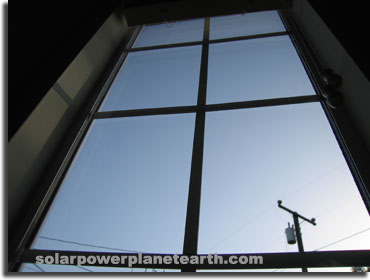 |
Energy Efficiency in and Around Your Home
The first step to reducing your carbon footprint and saving money is to reduce your the amount of energy you currently consume. Being energy efficient is not having a solar power system, it is how efficient your use of power is. Even though it is a must from an investment and environmental standpoint, getting a photovoltaic system should be the last of three steps in your quest to being planet friendly. The three steps are shown in the following graphic and explained below.
Step ONE - Passive Modifications
Passive modifications can be thought of making modifications to anything that does not draw its own power. Some of these items are very low cost, and some are not. Here is a list of passive modifications that should be made to the home in the order of lowest cost to highest cost:
Weather stripping around doors and windows - Air leaks around improperly sealed doors and windows have a huge contribution to energy loss in your home. It has been estimated that all of the gaps under doors, windows, recessed lighting, etc. add up to a 3ft diameter hole in your house! Imagine how much harder your air conditioning and heater have to work in order to keep your house at a comfortable temperature under these conditions. Weather stripping can be applied to door frames (as shown in the picture to the right), under and around garage doors, as well as windows. |
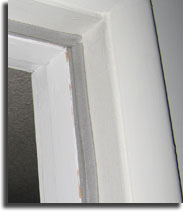 |
| Insulating your water heater and ALL your hot water pipes - Insulating your hot water pipes not only helps save energy by reducing the amount of times the burners in your water heater have to turn on to keep the water warm, but allow the hot water to reach your showers and sinks faster, reducing the amount of time the average person would need to leave their shower on before the water gets hot enough to get in, meaning you would be saving water as well. | 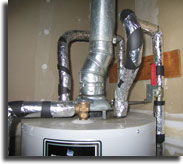 |
| Install appropriate amounts/types of insulation in walls and attic spaces - Stucco and drywall are not enough to insulate your house from significant heat loss. There are many types of insulation. Fiberglass batts, blown cellulose, and spray polyurethane foam are a few of the most popular. One additional advantage that spray foam insulation has is that it seals air leaks at the same time. (*30% Federal Tax Credit Eligible) | 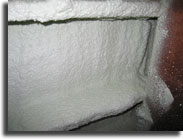 |
| Install reflective roofing - In most cases, a good majority of the heat gain coming into your home during the summer is coming from your roof. Dark roofing materials absorb the heat from the sun, making your air conditioner work much harder than it would otherwise. There are now highly reflective roofing materials that reduce the amount of heat absorbed. These new energy star rated roofing materials will certainly help lower your energy bills during the summer. (*30% Federal Tax Credit Eligible) |  |
| Replace exterior doors, including garage doors, with new, insulated, energy star rated doors - Modern energy efficient doors typically come with an interior filled with a foam insulation such as polyurethane, surrounded by a fiberglass exterior. The fiberglass shell can be designed to look like any number of types of wood, and in most cases almost indistinguishable (as shown in the picture to the right). These insulated fiberglass doors will typically have 5 times the insulating value of a similar size wooden door. In addition, they are maintenance free! No annual painting, sanding, re-finishing. Most manufacturers give you a lifetime warranty. (*30% Federal Tax Credit Eligible) | 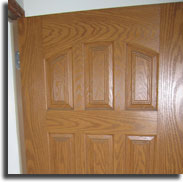 |
| Replacing all your old single pane windows with the latest low E gas filled double (or triple!) pane windows - Having multi-pane windows allows a layer insulation between the different layers of glass. This insulation can be just air as in older models, or a type of insulating gas, such as Krypton or Argon. This addition of gas and having multi-layers of glass drastically reduce the amount of heat gain through your windows. This keeps the hot air out during the summer and the hot air in during the winter. Double or triple pane windows are great sound insulators as well! (*30% Federal Tax Credit Eligible) | 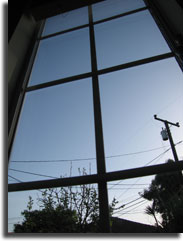 |
Step TWO - Active Modifications
Active modifications can be thought of as making modifications to anything that consumes power. This mainly involves replacing older inefficient technologies with the most energy efficient models available today.
| Replacing all your incandescent, halogen, and compact florescent (cFl) with Light Emitting Diode (LED) bulbs - LED light bulbs only use 10% the energy of an incandescent light, and 50% of the energy of a Compact Florescent bulb for the same amount of light! This can translate into tons of annual savings right off the bat! Light bulb efficiency is a measure of how much of the electrical energy is converted into light. A lot of the electrical energy in non-LED bulbs is wasted as heat (which is they are so hot when you touch them). The amount of heat generated by these older bulbs also makes your air conditioner work harder, further rasing your energy bills, so this is a great fix to make! Get some LED Lights today! | 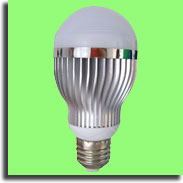 |
| Install a Solar Attic Fan - A lot of heat is trapped inside your attic during the summer, which is slowly transferred into your house, even after the sun goes down. By installing an active method of ventilation, you are removing the heat before it has a chance to enter into your living spaces. The most efficient and environmentally friendly way to do so, is to install a solar powered attic fan. These fans utilize a 12 volt DC motor which is typically powered with a small 10 watt solar panel. There are a few different styles, one such style, a solar powered gable vent fan, is shown in the picture to the right. Since these utilize low power low voltage DC, you don't have to pay an electrician to come out and install it. | 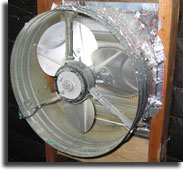 |
| Upgrade your old appliances, such as refrigerators, dish washers, washer/dryers, and televisions, with the newest energy star models - Even though new appliances can be costly, the additional cost you pay for a more efficient energy star model will pay for itself in the long run, and your helping the environment at the same time. Refrigerators are one of the biggest energy hogs in your home. Especially if your refrigerator is 10 years old or more, it should be replaced, since a new model of equivalent size will most likely use less than 50% of the energy your old one used, saving you well over $100 a year in electricity costs. Upgrading your dishwasher and washer/dryers, not only saves you money in electricity costs, but also in water. New models are much more efficient in the way they use water. There are now washing machines that use steam to wash your clothes, using one tenth the amount of water your old top loading machines would. | 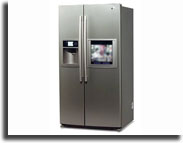 |
| Upgrading your Central Air Conditioner and Heater to the most efficient model currently available - The efficiency of air conditioners has come a long way. If your air conditioner is more than 10 years old, and you replace it with a new SEER 20 (Seasonal Energy Efficiency Rating) model or higher, you could potentially use 60% less power! When it comes to how efficient furnaces use gas, modern models have close to 96% efficiency compared to 80% or less from 10 years ago, saving you money on the cost of fuel during the winter. (*30% Federal Tax Credit Eligible) |  |
Step THREE - Install a Renewable Energy System
Now that you have made most if not all of the efficiency improvements mentioned above, install a renewable energy system. This completes your transformation to being environmentally friendly and making a great financial investment.
Be Careful Not to Misunderstand the Energy Star Label
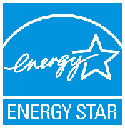 Just because an appliance has an energy star rating, does not mean it will cost very little to operate. For example, lets say you were out looking for a new efficient refrigerator, that would not cost a lot of money each year to run. You come across three "energy star" models of the same exact size. One is a top freezer style, one is a french door style, and one is a bottom freezer style. Since all three of these models are stamped with the energy star certification, does that mean they all burn very little power? No! The energy star label is defined as being a certain percentage below the government standard energy rating for that particular style and size refrigerator. Certain styles consume more power than others of the same size. Make sure you pay attention to this when shopping for new energy efficient appliances and electronics.
Just because an appliance has an energy star rating, does not mean it will cost very little to operate. For example, lets say you were out looking for a new efficient refrigerator, that would not cost a lot of money each year to run. You come across three "energy star" models of the same exact size. One is a top freezer style, one is a french door style, and one is a bottom freezer style. Since all three of these models are stamped with the energy star certification, does that mean they all burn very little power? No! The energy star label is defined as being a certain percentage below the government standard energy rating for that particular style and size refrigerator. Certain styles consume more power than others of the same size. Make sure you pay attention to this when shopping for new energy efficient appliances and electronics.
A good analogy for this point would be if you were shopping for a new car (assuming cars had an energy star label defined in the same manner explained above), and you had three cars to choose from. A 4 cylinder, a 6 cylinder, and an 8 cylinder car. Each of them was stamped with an energy star label for being the most efficient model in their class. Does that mean the 8 cylinder car is going to consume a small amount of gas and be environmentally friendly? No. The 4 cylinder energy star model would consume the least amount of fuel and consequently cost you the least to operate.
This does not mean the energy star certification is evil and you should ignore it. Energy star appliances and electronics are the most efficient in their class, and should be purchased. The above point was made since it is the goal of Solar Power for Planet Earth to assist in the reduction of each and everyone's carbon footprint to the maximum extent possible.